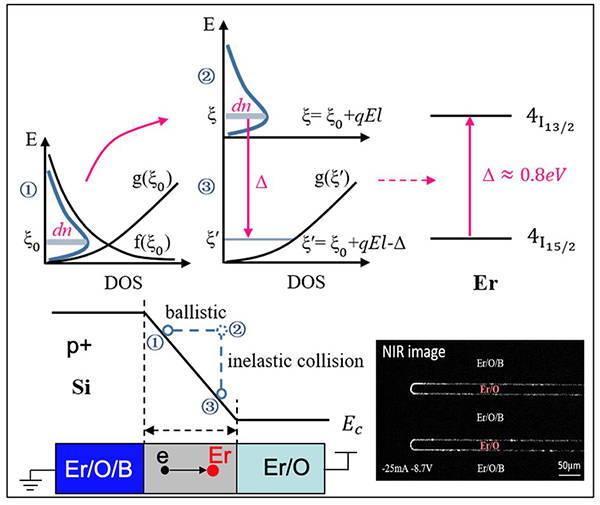Professor Yaping Dan from the University of Michigan-Shanghai Jiao Tong University Joint Institute (UM-SJTU JI, JI hereafter) has published a paper titled “Analytical impact excitation of Er/O/B co-doped Si light emitting diodes” in Physical Review Letters, a global top journal in physics. The paper with the latest finding of his research team explores the theory of impurity impact excitation in semiconductors and establishes an analytical expression for internal quantum efficiency, providing a theoretical basis for the design of light-emitting diode devices.
Yaping Dan is the corresponding author of the paper first-authored by JI Ph.D. student Xiaoming Wang. Contributors of the research also include Dr. Jiajing He from Shanghai Institute of Optics and Mechanics of Chinese Academy of Sciences, Professor Bao Hua and his Ph.D. students Ao Wang and Yufei Sheng from the Global Institute of Future Technology of Shanghai Jiao Tong University, Professor Weida Hu and Dr. Zhang Kun from Shanghai Institute of Technical Physics of Chinese Academy of Sciences, and Professor Chaoyuan Jin from Zhejiang University.

Figure 1. Principle of Er containing silicon diode under reverse bias and light emission image at communication wavelength.
Computer chips are made on silicon. Most of the existing chip technologies are developed for devices based on silicon. As of today, however, the signal processing speed of these chips are approaching their limit due to the relatively low speed of electrons. No particles run faster than light. Using light to transmit and process signals will have a much higher speed. Developing silicon based light processing devices, in particular light emitting diodes, is a natural choice for advanced chips in the future.
However, silicon is an extremely inefficient light emitting material. Developing efficient silicon light emitting diodes is a long-standing challenge. Introducing Er ions into silicon is a particularly interesting approach because Er ions can emit light at the communication wavelength of the current fiber network.
Previously, scientists found that Er containing silicon diodes are more efficient under reverse bias. However, the principle behind this phenomenon remains mysterious. Writing in the lastest issue of Physical Review Letters, X. Wang et al from Shanghai Jiao Tong University developed a device theory governing the emission properties of Er containing silicon diodes at reverse bias.
Professor Dan, who spearheaded the device theory, said: “This device theory reveals the physics inside Er containing Si diodes at reverse bias. Excitingly, it will also guide us to develop more efficient silicon based light sources, in particular, single photon emitters for quantum computing.”
Author Biography

Xiaoming Wang is a Ph.D. student at the UM-SJTU Joint Institute. Her research efforts focus on developing silicon-based light sources at telecommunication wavelength.

Yaping Dan is currently holding the full Professorship of Shanghai Jiao Tong University. He received his Bachelor degree in electrical engineering from Xi’an Jiaotong University in 1999, Master’s degree in microelectronics from Tsinghua University in 2002, and Ph.D. in electrical engineering from the University of Pennsylvania in 2008. He was a postdoctoral fellow at Harvard University before joining the joint institute in 2012 as an associate professor. He was tenured in 2020 and promoted to the rank of full professor in December 2021. He was appointed as the associate editor of AIP Advances and Frontiers in Physics starting in June, 2022, and elected in 2023 as Fellow of Institute of Engineering and Technology (FIET), UK. His research efforts focus on developing all-silicon optoelectronics and single-atom electronics, providing key solutions for future advanced integrated circuits and quantum computing technologies.





